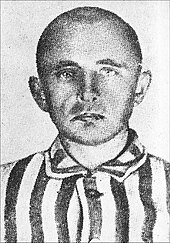Resistance movement in Auschwitz

The organization of underground resistance movements in
Background
After the western part of the country was
Reichsführer-SS Heinrich Himmler, head of the Schutzstaffel (SS), approved the site in April 1940, intending to use the facility to house political prisoners. SS-Obersturmbannführer (lieutenant colonel) Rudolf Höss oversaw the development of the camp and served as the first commandant. SS-Obersturmführer (senior lieutenant) Josef Kramer was appointed Höss's deputy. Auschwitz I, the original camp, became the administrative center for the whole complex.[5][6]
Auschwitz was the first concentration camp in south-western Poland under the German occupation. Similar structures were utilized to form
In 1940 the number of former Polish soldiers and civilians sent to Auschwitz gave rise to suspicions about Germany's intent. Pilecki made a decision to place himself there willingly. On 19 September 1940 during a round-up in Żoliborz district of Warsaw, Pilecki was arrested and soon sent off to Auschwitz (prisoner no. 4859). Further proof that he entered the camp voluntarily came in the autumn of 1941 when Pilecki received a promotion to the rank of lieutenant from the Warsaw underground.
At about the same time, imprisoned activists of the
International resistance

By the end of 1942, with the camp now housing prisoners from all across Europe, other resistance cells appeared, usually formed along national and ethnic lines. In addition to a Jewish resistance group, there existed Czech, Russian, Yugoslav, French, Austrian and German ones, mostly with a leftist or socialist political bent. An international organization,
The main objectives of the resistance movements were to help prisoners survive, to collect intelligence on Nazi atrocities in the camps, to organize escapes, and to prepare for an eventual uprising within the camp. The last of these never materialized, although several mass mutinies occurred, most notably that of the
The role of communist resistance, both Polish and international, has been unduly exaggerated by the communist-era historiography and other works in communist-era USSR and its satellite states such as Poland; further, communist era historiography attempted to suppress the information about the Home Army members inside the camp and their role in the resistance.[10]
Notes
- ^ a b c "Auschwitz-Birkenau - The resistance movement". En.auschwitz.org. 1943-10-10. Retrieved 2013-09-01.
- ^ a b "Auschwitz-Birkenau - The resistance movement". En.auschwitz.org. Retrieved 2013-09-06.
- ^ a b Lidia Świerczek, Pilecki's life Institute of National Remembrance. Last accessed on 14 March 2009.
- ^ Dwork & van Pelt 2002, p. 166.
- ^ Gutman 1994, pp. 10, 16.
- ^ Steinbacher 2005, pp. 22–23.
- ^ Marek Przybyszewski, IBH Opracowania - Działdowo jako centrum administracyjne ziemi sasińskiej (Działdowo as centre of local administration). Internet Archive, 22 October 2010.
- ^ Lidia Świerczek, the Muzeum of Wola. "Rotamaster Pilecki - Biography - Part 3". Rotamaster Witold Pilecki. Institute of National Remembrance. Retrieved 8 January 2016.
- ^ "Resistance During the Holocaust". Iearn.org. Archived from the original on 2000-11-21. Retrieved 2013-09-01.
- )
References
- Dwork, Debórah; van Pelt, Robert Jan (2002). Auschwitz. New York: Norton. ISBN 0-393-32291-2.
- ISBN 0-253-32684-2.
- Steinbacher, Sybille (2005) [2004]. Auschwitz: A History. Munich: Verlag C. H. Beck. ISBN 0-06-082581-2.
Further reading
- Jozef Garlinski (2018). Fighting Auschwitz: The Resistance Movement in the Concentration Camp. Aquila Polonica Publishing. ISBN 978-1-60772-024-9.
